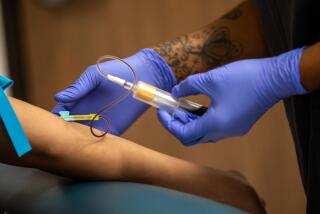AIDS Cost to County Expected to Climb to $805 Million in 1991
- Share via
By 1991, AIDS will be costing San Diego County $805 million a year in health-care costs and lost wages of the 1,900 people who are expected to have active cases, an analysis at San Diego State University concludes.
That is 1.2% of the total cost of AIDS estimated for the nation that year.
It is also more than the community can expect to be losing annually to auto accidents, lung cancer, kidney disease or breast cancer.
Caution About Estimates
But the study’s authors cautioned that the assumptions behind the estimates could change rapidly because there are so many uncertainties in the AIDS picture.
“It really is very difficult to make these projections, because the amount of uncertainty in terms of the future is just phenomenal. It’s even difficult to know how many cases exist now or will exist in the future,” said Stephen J. Williams, professor of public health at SDSU.
But Williams added that the study is an indication nonetheless of the magnitude of the economic problem AIDS presents.
“The figures show that increasing resources will have to be spent to deal with this crisis, and that we’d better start planning now for that expense,” he said.
Williams co-wrote the study with Robert L. Seidman, assistant professor of public health and economics, and Lynn M. Mortenson, a research assistant and graduate student.
It will be presented today on the opening day of an SDSU conference, “AIDS in the Community: Where Are We?” Six hundred people, mostly local health professionals, are expected to attend the two-day meeting.
By reviewing literature on AIDS and studying state and federal projections of the progress of the fatal disease, the study team made adjustments for the disease’s pattern in San Diego and concluded that:
- AIDS cost $105.3 million in San Diego County in 1986. That included the costs of publicly and privately funded medical care, research, drugs, testing for infection, blood-supply screening and education programs, and the cost of lost productivity from patients disabled or killed by the disease.
- Lost productivity of the victims accounts for more than 70% of the total cost of the disease.
- In 1986 dollars, the annual cost of AIDS will have increased 488% by 1991.
Lance Clem, spokesman for the San Diego AIDS Project, said he was not surprised by the figures.
“AIDS is an expensive illness, for a lot of reasons. It requires a lot of hospitalization. It requires experimental treatments. It requires long-term care--and complicated care,” Clem said. “But I think there are advances going on all the time that will produce medication that will tend to keep the cost of hospitalizing and institutionalizing people down.”
Williams agreed that new drugs or a vaccine could markedly change the cost of the disease in the county. So, too, would a shift in the kinds of people AIDS is afflicting.
So far, San Diego has not seen a shift in the prevalence of new AIDS cases away from homosexuals and into drug abusers, as has occurred in the East.
About 80% of San Diego’s 817 AIDS cases through March were among homosexuals, contrasted with 63% nationwide. Only 3% were among intravenous drug users, contrasted with 18% nationwide. The remainder consist of people who acquired AIDS through contaminated blood products or heterosexual contact.
But there are an estimated 15,000 to 21,000 intravenous drug abusers in San Diego County who are at risk of getting AIDS because of their drug use, said Melinda Newman, county drug program administrator.
The study was financed by SDSU and Scripps Clinic & Research Foundation, which recently established a Health Policy Center that Williams heads.
More to Read
Sign up for Essential California
The most important California stories and recommendations in your inbox every morning.
You may occasionally receive promotional content from the Los Angeles Times.













